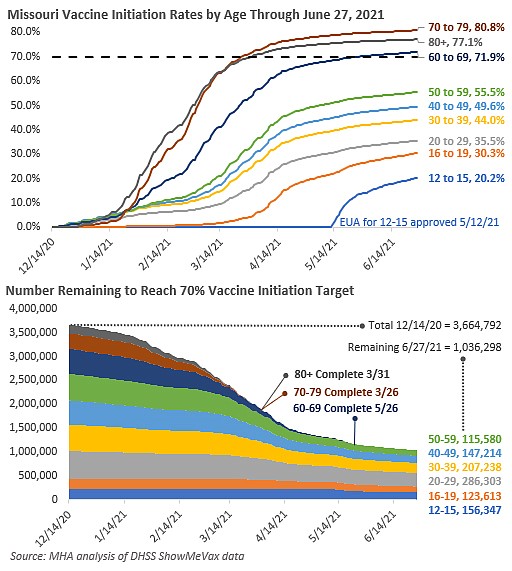When COVID-19 vaccinations came available, Missouri did a commendable job of getting vaccinations into the arms of people who needed them most - those 60 and older. But overall, the state has fallen short of goals intended to stop the spread of COVID-19, according to data from the Missouri Department of Health and Senior Services.
As of Thursday, 2,728,324 residents (about 44.5 percent) - had initiated coronavirus vaccinations - and 2,399,219 (about 39.1 percent) had completed the process, according to the state's website.
The Pfizer and Moderna vaccinations each require two doses. The Johnson & Johnson vaccine requires only one.
President Joe Biden established a goal of having 70 percent vaccination initiation nationwide by today, but it was not reached.
The failure is not for lack of vaccinations available. Demand for the vaccinations has been low - especially among younger people, health care officials said.
A Missouri Hospital Association analysis of state data shows as Missouri received enough vaccine to match demand, demand was decreasing.
There is good news in the data, MHA spokesman Dave Dillon said.
Missouri's vaccination distribution plan was heavily front-loaded to protect seniors and people with health conditions that made them more susceptible to COVID-19-caused severe symptoms than younger or healthier people, he said.
"Seniors were acutely aware that the disease was wreaking havoc with their community. It was clearer that vaccination was their path to protection earlier," Dillon said. "All of the evidence pointed toward - getting vaccinated would provide some degree of protection."
And seniors did get vaccinated.
Seniors make up the only age groups in the state that have reached the goal of 70 percent vaccination to help protect them from the disease.
A reason to aspire to 70 percent vaccination rates is that if the overall population reaches about 70 percent, herd immunity begins to set in. Herd immunity occurs when most of a population is immune to an infectious disease, providing indirect protection to those who are not immune.
Although more than 70 percent of seniors have received the vaccinations in Missouri, they are not protected by herd immunity because the overall population's vaccination rate remains around 40 percent.
So it's important for the rest of the state's population to reach 70 percent vaccinations, Dillon said.
Vaccine supplies began rolling out in mid-December. As they did, Missouri illnesses peaked.
Availability of vaccines was "very much in people's consciousness at that point," Dillon said. "Demand was far exceeding supply of vaccine. It would continue for a couple of months."
Then the rates of vaccinations flattened for each age group.
Missourians ages 70 and older managed to be vaccinated at rates above 70 percent by March. Missourians ages 60-69 reached 70 percent vaccination rates around Mid-May.
As vaccines came available, there was early demand in each age group, but all flattened out, MHA data show.
Missourians ages 50-59 have reached about 55.5 percent vaccination; ages 40-49, 49.6 percent; ages 30-39, 44 percent; ages 20-29, 35.5 percent; and ages 16-19, 30.3 percent.
Vaccinations for adolescents (ages 12-15) were approved for emergency use in mid-May. About 20.2 percent of that age group is vaccinated.
Cole County's vaccination rate is about 40 percent.
It's not for lack of trying, said Chezney Schulte, Cole County Health Department communicable disease coordinator.
All health care agencies in Central Missouri are trying to make COVID-19 vaccinations as accessible as possible, she said, through mass-vaccination sites, clinics, pharmacies and mobile platforms.
"There is certainly not a shortage of vaccine in the community, and people must take personal responsibility to pursue a vaccine at a date, time and location that works best for them," she said in an email to the News Tribune.
She added - while details are unavailable - Missouri Department of Health and Senior Services has discussed an incentive program for vaccinations statewide.
She added natural infections add to the percentage of the population that has antibodies against COVID-19.
Missourians continue to be hesitant to receive vaccinations.
The MHA analysis shows over the past two weeks, an average of only 3,339 Missourians ages 12-59 have initiated vaccinations each day. At that rate, Missouri would not reach 70 percent vaccination until May 2022.
The lack of vaccinations is opening a door for the delta variant to walk through, Dillon said.
The analysis points out Missouri has led the United States in new cases and cases caused by the delta variant.
"We're seeing in communities where this is spiking, that (delta) is the primary variant," Dillon said. "The delta variant is becoming the primary variant. It's known to be virulent. It's just so much more transferable."
The virus, for example, is hitting Southwest Missouri hard, he added. Counties in that portion of Missouri have varying vaccination rates.
Jasper County (20.9 percent) and Newton County (17.9 percent), which together contain Joplin, along with McDonald County (14.1 percent), have very low vaccination completion rates, he said.
Vaccination rates by county may be found at covidvaccine.mo.gov/data.
"That just allows the virus to replicate throughout those communities," Dillon said. "We need to encourage people to continue to vaccinate. And if you haven't and have none of the antibodies in your system, the smart thing to do is vaccinate."

